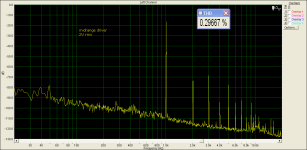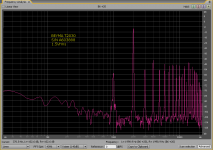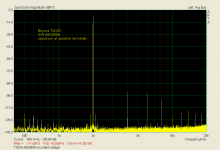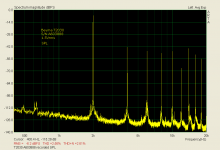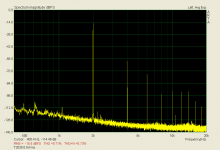A resonance starts to respond instantly with the application of the driving force. It builds over time, but this time frame is exceedingly short when compared to the travel time of a wave diffracted or reflected within the horn body, which does nothing at the listening point until this secondary wave arrives. These are dramatically different time scales.
Not at all, there are resonances in acoustic and mechanical systems that have a link between driving force and resonant mechanism. So not necessarily "instantly".
For example.. coupling to a room mode in an adjacent space in a listening set up. This is a non min phase thingy which you can not use a simple EQ to compensate.
Resonance in room walls. The walls can not possibly start to resonate before the air pressure wave hits it. Time of travel from speaker to wall you know.
What gedlee is saying is that "A resonance starts to respond instantly with the application of the driving force."
The driving force in the case of room walls resonance is the sonundwave. It has nothing to do with the speakers.. if the room resonance is for example 120hz, the very instant a sound with 120hz enters the room it will trigger the resonance.
Pan - you are just not worth discussing things with.
Why? Because my findings contradict your claims?
What gedlee is saying is that "A resonance starts to respond instantly with the application of the driving force."
The driving force in the case of room walls resonance is the sonundwave. It has nothing to do with the speakers.. if the room resonance is for example 120hz, the very instant a sound with 120hz enters the room it will trigger the resonance.
gedlee said:A resonance starts to respond instantly with the application of the driving force. It builds over time, but this time frame is exceedingly short when compared to the travel time of a wave diffracted or reflected within the horn body, which does nothing at the listening point until this secondary wave arrives. These are dramatically different time scales.
RuneStone;
I leave it to you to do the math for a high Q cone resonance decay and compare that to the diffraction delay in a small or moderate sized horn. Gedlee is wrong, or as is very common, simplifying and generalizing to the point of seeming confused or wrong about the issue. He hates me for pointing it out by the way. 🙂
...(FrankWW, it is diffraction not refraction)...
Thanks. I think cognitive decline has set in.😱
Art - Lidia and I did an AES paper on exactly the group delay increased audibility with SPL. It was a preprint and because of a death in Lidia's family it was not presented - live, but was shown as a poster. For that reason not many saw it, but it was presented and I believe it is on my website.
I just don't agree with you statement that 6 dB is too small since the THD almost doubled in that range. And, as I said, I did the distorted versus unmodified listening test myself and I could not detect the difference. Any test has its limitations and they can all be criticized - yours, Klippel's, mine non of them are perfect. Is Klippel's blind? That's a big thing in this context.
By "no one cares" I meant that the big companies like Harman, etc. all believe like I believe, that NLD is not a major factor (Toole does not even measure it!). So who is going to support such studies? Not any of them. Do you have a check book? Just send along a check and I'll get right on it.
I know of no scientifically accepted study that has shown NLD to be a major subjective issue and making ridiculous statements like "If harmonics could not be heard, one could not tell the difference between an upright bass, a cello or a violin." is not going to change that.
Again - why do the experts at Harman, etc. all agree with me? You haven't explained that to me yet.
I just don't agree with you statement that 6 dB is too small since the THD almost doubled in that range. And, as I said, I did the distorted versus unmodified listening test myself and I could not detect the difference. Any test has its limitations and they can all be criticized - yours, Klippel's, mine non of them are perfect. Is Klippel's blind? That's a big thing in this context.
By "no one cares" I meant that the big companies like Harman, etc. all believe like I believe, that NLD is not a major factor (Toole does not even measure it!). So who is going to support such studies? Not any of them. Do you have a check book? Just send along a check and I'll get right on it.
I know of no scientifically accepted study that has shown NLD to be a major subjective issue and making ridiculous statements like "If harmonics could not be heard, one could not tell the difference between an upright bass, a cello or a violin." is not going to change that.
Again - why do the experts at Harman, etc. all agree with me? You haven't explained that to me yet.
Last edited:
What gedlee is saying is that "A resonance starts to respond instantly with the application of the driving force."
The driving force in the case of room walls resonance is the sonundwave. It has nothing to do with the speakers.. if the room resonance is for example 120hz, the very instant a sound with 120hz enters the room it will trigger the resonance.
Actually we were talking about cones, not rooms. And the response does start immediately upon excitation just as I said.
sorry i just want to be certain of the term NLD=Non Linear Distortion
ok NLD is a"Non Issue" so is linear distortion an issue or not?
sorry if my queries seem trite or un-enlightened but i am still trying to figure out this distortion in horns thing...
ok NLD is a"Non Issue" so is linear distortion an issue or not?
sorry if my queries seem trite or un-enlightened but i am still trying to figure out this distortion in horns thing...
Last edited:
I almost never see a speaker that is not dominated by 2nd and 3rd order. Some years back a client of mine did a gauge reliability study of the Kilppel system using a single driver measured several times. The second and third orders that it calculated were stable, but nothing higher. These higher orders have inherently built in limitations in mechanical systems because of inertia and the like. Very high forces are generated by high orders of nonlinearity. In an electrical system theses forces are voltage and there is almost always excess voltage available to generate these higher orders. In a mechanical system these forces are difficult to generate since the system does not have much "force" to spare. This is why mechanical systems tend towards low orders of nonlinearity.
This is an important point. Audibility of low-order nonlinear distortion (2nd and 3rd harmonic) is less than most of us expect (I find it hard to hear less than 1%, for example). The reverse is true of high-order nonlinear distortion (5th and higher); it might be difficult to measure (because the absolute levels are low and potentially swamped by noise), but easy to hear as "roughness", "harsh", or "mechanical" sound.
Dr. Geddes reminds us to look at the mechanisms that create nonlinear distortion and see if they preferentially create low or high-order distortion. Voice-coil rubs, for instance, will create a lot of level-dependent high-order distortion, or looking at it another way, program-modulated noise. It's a defect, but not that uncommon. Bad examples do slip into production, and manufacturers don't always have QC measures in place to prevent this. At a lower level, low-level artifacts from stiction in the spider of a bass driver may not be easy to measure, but might be audible, depending on how badly the spider is designed. Not all bass drivers have linear spiders.
In amplifier design (transistor and vacuum-tube) it's easy to be distracted by 2nd and 3rd harmonic distortion. In practice, though, all it usually indicates is the presence of an outright defect; a bad part, or a circuit design error. What you hear, though, are more subtle high-order terms as a result of Class AB transitions, or 100/120 Hz power-supply harmonic buzz getting into places it doesn't belong. A simple way to look at any amplifier is examine the potential sources of switching noise, and if this switching noise is dynamically affected by the presence of program material.
Last edited:
sorry i just want to be certain of the term NLD=Non Linear Distortion
ok NLD is a"Non Issue" so is linear distortion an issue or not?
sorry if my queries seem trite or un-enlightened but i am still trying to figure out this distortion in horns thing...
No, nothing is an issue, you just fix it and "be done with it". ;-)
Seriously, everything is an issue and nonlinear is one of the biggest if not the biggest.
Art - Lidia and I did an AES paper on exactly the group delay increased audibility with SPL. It was a preprint and because of a death in Lidia's family it was not presented - live, but was shown as a poster. For that reason not many saw it, but it was presented and I believe it is on my website.
If memory serves me that study was on diffraction or a pure delay with resulting combfilter effects right?
To me it's a bit confusing to claim that GD increases in audibility based on that since there are other "types" of GD such as the phase shift of filters. I've never heard the term used for discrete delay or reflection with resulting ripple/comb filtering.
Last edited:
Art - Lidia and I did an AES paper on exactly the group delay increased audibility with SPL.
This convention paper has been reproduced from the author's advance manuscript, without editing, corrections, or consideration by the Review Board. The AES takes no responsibility for the contents.
sorry i just noticed this disclaimer at the top of your AES paper
so i guess these three dutch guys are wasting their timeI know of no scientifically accepted study that has shown NLD to be a major subjective issue
http://doc.utwente.nl/58981/1/Schurer94modeling.pdf
care to supply us with individual names? or contact them and see if they care to state that here it would remove all doubt about the veracity of your claim.Again - why do the experts at Harman, etc. all agree with me? You haven't explained that to me yet.
This is an important point. Audibility of low-order nonlinear distortion (2nd and 3rd harmonic) is less than most of us expect (I find it hard to hear less than 1%, for example).
It's my impression that today most people actually acknowledge that.
The various forms of modulation distortion that can result from a device with 1% HD is another story though.
1)Art - Lidia and I did an AES paper on exactly the group delay increased audibility with SPL.
2)I just don't agree with you statement that 6 dB is too small since the THD almost doubled in that range. And, as I said, I did the distorted versus unmodified listening test myself and I could not detect the difference.
3)Any test has its limitations and they can all be criticized - yours, Klippel's, mine non of them are perfect. Is Klippel's blind?
4)By "no one cares" I meant that the big companies like Harman, etc. all believe like I believe, that NLD is not a major factor (Toole does not even measure it!).
1) Audibility of Linear Distortion with Variations in Sound Pressure Level and Group Delay
"The results of this study indicated that within the constraints of this simple study that the perception of linear distortion is dependent on the level and the delay time of the linear distortion and the playback level."
Your conclusions in that study seem valid. I also find THD and IM distortions to be much more evident at louder playback levels.
2) I have compared recordings of horn/drivers to the original, at low levels of distortion I can't tell them apart, at high levels of distortion I can easily tell them apart, and find the high levels of distortion to sound awful. Simply comparing distorted drivers to 6 dB more distorted drivers using music with a fair degree of distortion makes it hard to tell them from the original.
Sorry to hear you couldn't detect those high levels of distortion, that's the first time I recall you said that.
3) Yes, it is blind, give it a try.
4) Whether NLD is or is not a "major factor" of major companies does not mean it is not one of the many factors addressed by them. The introduction of JBL's D2 (double diaphragm) driver specifically addresses distortion, they claim:
"Extended HF Reproduction
Smoother Response
Higher power handling
Lower distortion
Reduced power compression
Increased Dynamic Headroom"
JBL's priorities seem fairly close to mine, never seen any of their engineers claiming NLD is a non-issue.
Art
But if you have other examples of drivers which have higher orders comparable to the 2nd or 3rd and cannot be called broken, then I would like to see that data.
I have quite enough measurements that show high order harmonics in driver spectra, one of them is attached, but I do not want to identify the drivers.
The reverse is true of high-order nonlinear distortion (5th and higher); it might be difficult to measure (because the absolute levels are low and potentially swamped by noise), but easy to hear as "roughness", "harsh", or "mechanical" sound.
IME it is possible to measure higher order harmonics if we have enough dynamic range of our measurements, which is the case in the close proximity of the speaker.
It is also interesting to make a spectral analysis of speaker current (I have some measurements on my web page), speaker current spectrum reflects impedance non-linearities and thus driver non-linearities.
These driver non-linearities also reflect into amplifier output voltage, the ratio would be Zout/Zdriver. The higher Zout of the amplifier, the more we can see it at amplifier output voltage, even if it is a true class A with negligible distortion. However, speaker (driver) current distortion will be of orders higher than amplifier output voltage distortion.
Attachments
This is another S/N of T2030 with sub-harmonic distortion. 2kHz recorded file
http://pmacura.cz/T2030_A603888_2kHz.wav
and spectrum, sub-harmonics in 2nd half of the file.
Edit: attached is also a spectrum of voltage at speaker terminals and SPL spectrum at high resolution (no sub-harmonic at the moment)
http://pmacura.cz/T2030_A603888_2kHz.wav
and spectrum, sub-harmonics in 2nd half of the file.
Edit: attached is also a spectrum of voltage at speaker terminals and SPL spectrum at high resolution (no sub-harmonic at the moment)
Attachments
Last edited:
Why would you do that? Is this another "test" of yours, with uncertain conditions, measuring methodology and/or misleading conclusions?, but I do not want to identify the drivers.
Anyway, is this some kind of a polite game you are playing here or are you slowly revealing your true face and how you act on CZ/SK forums; mocking at his work and the personality of E.G.? 😕
If harmonics could not be heard, one could not tell the difference between an upright bass, a cello or a violin.
Art
I like this quote! So true.
Why would you do that? Is this another "test" of yours, with uncertain conditions, measuring methodology and/or misleading conclusions?
The conditions are well defined and have been described. Speaker terminals voltage is 1.5Vrms, near-field measurement with microphone 4cm from membrane, the voltage records were posted here and anyone interested may make his own analysis of the data measured. Voltage distortion at speaker terminals has been shown as well.
In case you have any relevant comment, I will gladly read it and answer it.
The problem with this driver is indicated by rise of higher order harmonics. As long as the envelope of the spectrum has decaying shape, the result is OK. For this driver, it was, unfortunately, only up to 0.5Vrms. The rise of higher harmonics is not only measurable, but it is clearly audible. The ear detects it with same reliability as the measuring microphone.
Attachments
Klippel test is actually double blind. Meaning automated random generator sets up the choices son that even the test administrator doesn't know the answer. This removes even possible test administrator bias.
- Status
- Not open for further replies.
- Home
- Loudspeakers
- Multi-Way
- Audibility of distortion in horns!
